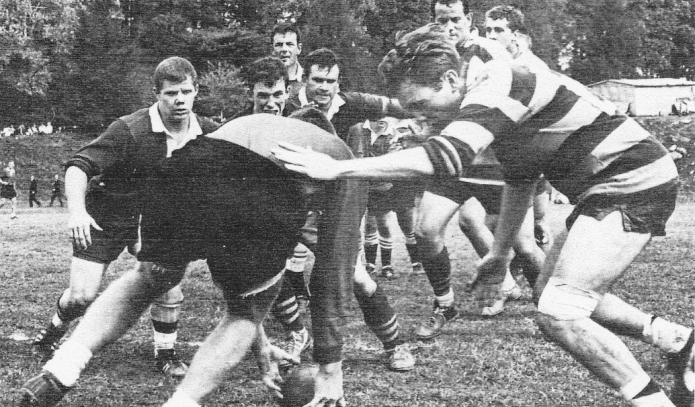With the Rugby World Cup Final about to emotionally drain me for another weekend I thought it was worth briefly looking at a great chapter when three of my favourite things combined: Rugby, Canberra and Civil Disobedience.
Let me take you back to the good ol’ days when Rugby was amateur, people cared enough to take to the streets and South Africa was oppressed under the jackboot of the apartheid state.
ACT v South Africa
In 1971 the South African Rugby Team toured Australia and everywhere they went they were met with anti-apartheid protests. On 21 July 1971 they played at Manuka Oval in Canberra.
The picturesque white-picket fence of Manuka Oval was complemented with two lines of police officers and a 2 metre fence was erected around the boundary for the first time with sandbags placed over any loose fittings to prevent protestors using them as weapons. Additionally and rare for the time as, patrons were searched for bottles and cans for the first major usage of the Public Order (Protection of Persons and Property) Act.
The Menzies government had recently brought in the Public Order (Protection of Persons and Property) Act in May 13, 1971 to fill the gap in the law that prevented police from taking action against otherwise lawful protests.
Kindly, the “apparent policy of A.C.T. police has been to provide close escort, or a major show of force, for large demonstrations” but that actively combatting civil unrest “often tends to make the crowd remain compact, and likely to react violently to any attempts to break it up.”
The Police came down on the protesters in large numbers, but did not attempt to prevent or disperse the actual protest. Presumably a state based aggressive response to a peaceful protest against another state’s based aggression seemed a little too ironic. 400 Police came from NSW to assist their ACT colleagues.
The Canberra Times quoted a protester who complemented the ACT Police that day “I’ve seen police a lot rougher than they were here. In NSW they kick first, then ask them to move on.”
Over 1,000 protestors piled into Manuka Oval with whistles, making the entire match entirely insufferable for the players who were subjected to the non-stop blow of whistles making the referee’s calls almost impossible to hear.
Unfortunately the video was too large to post but here is a great 5 min clip of the game providing a perfect idea of how noisy the protesters were. 62 charges were laid that day and the issue became a point of contention in Parliament.
Over the course of the tour a number of players excluded themselves from the home teams in protest over the policies of the South African Government.
The game finished in a 34-3 drubbing of the ACT but the South African captain Hannes Marais stated that it was a hard and enjoyable game. South Africa stayed undefeated during the tour.
Wider Implications
The UN declared 1971 the International Year of Action to Combat Racism.
A SA cricket tour was scheduled for the 1971-72 summer tour but was cancelled and replaced with a World XI when the Chairman of the Australian Cricket Board, some guy called Donald Bradman, declared that there would be no more tours allowed from South Africa until the team was selected on a non-racial basis.
Australia was forced to examine its own attitudes towards it’s indigenous population in light of our ardent criticism of the South African regime and the hypocrisy that came with that stance.
The Whitlam Government later introduced a Government ban on sporting tours from South Africa, which was kept in place by subsequent governments and credited largely for the 1977 Gleneagles Agreement at the Commonwealth Heads of Government Meeting general ban on sporting relations between the Commonwealth and South Africa. The Commonwealth ban was echoed by the Soviet Union, but importantly not the United States.
The Commonwealth ban particularly hurt South Africa as their two major sports, Rugby and Cricket, were played almost exclusively in Commonwealth nations.
Despite the ban, New Zealand allowed the Springboks to tour in 1981 despite widespread public protest and International condemnation. NZ considered SA to be their greatest rival and did not want to pass up the opportunity to test their mettle. NZ subsequently came into line with the international position and no further tours occurred until the collapse of apartheid in 1994.
The Australian role in leading the charge against international sporting engagement with SA is considered to be one of the better weapons used against the SA government to highlight to it and its people just how out of touch their racist policies were with the rest of the world. The stance by the various boards and Whitlam government can be attributed in no small part to the popular protests that disrupted the Springbok tour and highlighted the morally shaky position of criticising a regime as racist but continuing to engage with it.
My basic premise is that: Protests around Australia followed the SA tour around, Canberra students et al. protest in ’71, in ’72 Cricket Australia bans SA and Whitlam bans any racially selected teams and then in ’77 the Gleneagles Agreement is signed…ergo, small events in Canberra can change the world if the momentum is right and the passions are running strongly enough.


